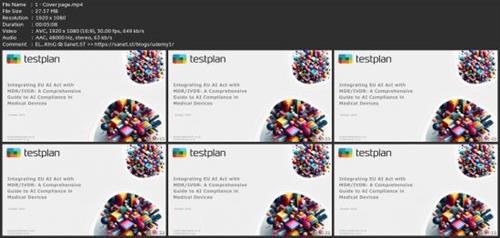
Published 11/2024
MP4 | Video: h264, 1920x1080 | Audio: AAC, 44.1 KHz
Language: English | Size: 1.22 GB | Duration: 3h 59m
Integrating AI Compliance with MDR/IVDR through risk management, transparency, and post-market surveillance
What you'll learn
Integrate AI compliance with MDR/IVDR regulations for medical devices and healthcare solutions.
Understand AI-specific risk management strategies, including transparency, bias mitigation, and cybersecurity.
Develop technical documentation that aligns with both AI-specific and MDR/IVDR requirements.
Conduct effective post-market surveillance for AI-enabled medical devices to ensure ongoing compliance.
Requirements
Basic understanding of medical devices and AI technology is helpful but not required.
No specific tools are required, just a willingness to explore AI compliance in the healthcare sector.
Description
Why This Training is Important:• Regulatory Landscape Transformation: The intersection of the EU AI Act with the Medical Device Regulation (MDR) and In Vitro Diagnostic Regulation (IVDR) represents a significant transformation in the European regulatory framework. AI technologies, particularly in healthcare, are rapidly evolving, and understanding how they fit into existing medical device laws is crucial for ensuring compliance and innovation.• AI in Medical Devices: With the increasing integration of AI into medical devices-such as diagnostic tools, treatment planning systems, and patient monitoring-regulatory professionals need to understand the dual obligations under both the AI Act and MDR/IVDR. Failure to do so could result in non-compliance, delayed market entry, or potential legal repercussions.• Enhanced Patient Safety: Ensuring compliance with these regulations not only satisfies legal obligations but also ensures that AI-powered medical devices are safe, reliable, and able to protect patient rights and safety. The ethical considerations of AI, such as transparency and the elimination of bias, play a vital role in safeguarding patient outcomes.For Whom the Training is Designed:• Medical Device Manufacturers: Professionals involved in developing, testing, and marketing AI-driven medical devices, especially those responsible for regulatory compliance.• Regulatory Affairs Experts: Individuals responsible for ensuring that AI systems meet the stringent requirements of both the AI Act and MDR/IVDR.• AI System Developers: Those building AI modules for use in medical devices, who need to understand the compliance requirements of both frameworks, especially regarding human oversight, algorithmic transparency, and ongoing monitoring.• Healthcare Industry Professionals: Stakeholders interested in understanding how AI technologies in medical devices must align with both technical safety standards and broader ethical requirements.Key Deliverables:• Comprehensive Understanding of the AI Act: Detailed breakdown of the EU AI Act, focusing on high-risk AI systems in healthcare and their regulatory requirements, including algorithm transparency, bias mitigation, and human oversight.• Integration with MDR/IVDR: Clear pathways for integrating AI compliance within the broader MDR/IVDR regulatory frameworks, ensuring that AI systems meet both ethical and performance standards.• Risk Management Frameworks: Insights into risk management strategies tailored for AI systems, aligned with ISO 14971 and IEC 62304 standards. This includes identifying AI-specific risks, such as algorithmic unpredictability and cybersecurity vulnerabilities, and incorporating them into risk management plans.• Post-Market Surveillance: Understanding how to conduct continuous monitoring and update technical documentation to ensure that AI systems maintain compliance throughout their lifecycle, especially as algorithms evolve through machine learning.How This Training Helps Understand EU AI Act and Its Integration into the European Regulatory Framework:• Holistic Compliance Strategy: Provides a dual-framework approach, explaining how the AI Act's requirements for transparency, bias mitigation, and human oversight complement MDR/IVDR's focus on device safety and performance.• Practical Application: Detailed guidance on how AI-specific risks-such as biases, data governance, and algorithm transparency-are managed from the design phase through post-market activities. The training ensures that participants know how to harmonize both AI and medical device regulations.• Future Trends: Discusses emerging trends in AI regulation, such as the growing importance of real-time algorithm monitoring and ethical AI decision-making. The training also anticipates further regulatory developments, preparing learners for the evolving landscape of AI integration in healthcare.Other Key Points Covered:• Conformity Assessment: Steps to ensure that AI-enabled devices pass conformity assessments under both the AI Act and MDR/IVDR, focusing on high-risk applications.• Documentation and Technical Files: Detailed explanation of how to compile and maintain technical documentation that meets both AI-specific and medical device-specific compliance standards.• Ethical AI Deployment: Highlights the importance of embedding ethical considerations such as fairness, accountability, and human rights protection into the development and deployment of AI systems in medical devices.• Integration of AI Modules: Best practices for incorporating AI modules into medical devices while ensuring ongoing regulatory compliance and risk management.This training ensures that professionals involved in AI medical devices are equipped to navigate the evolving regulatory landscape, making them confident in achieving compliance while driving innovation.
Overview
Section 1: Start
Lecture 1 Cover page
Lecture 2 Course Agenda and Evaluation Overview
Section 2: 1. | Introduction and Purpose (4 slides)
Lecture 3 1. | Agenda
Lecture 4 1.1 (Slides 1 and 2: Introduction to Training Goals and Objectives)
Lecture 5 1.2 (Slides 3 and 4: The Importance of AI Compliance and Learning Outcomes)
Section 3: 2. | Foundations of MDR/IVDR and AI Act Overview (6 slides)
Lecture 6 2. | Agenda
Lecture 7 2.1 (Slides 5 and 6: MDR/IVDR Framework & AI Act Overview)
Lecture 8 2.2 (Slides 7 and 8: Core Differences: MDR/IVDR vs. AI Act)
Lecture 9 2.3 (Slides 9 and 10: Addressing AI Gaps with AI Act Support)
Section 4: Understanding the EU AI Act: Focus on Compliance (11 slides)
Lecture 10 Section 3: Agenda
Lecture 11 Slide 11: Visualization |Of the AI Act & MDR/IVDR.
Lecture 12 Slides 12 & 13 (Overview of the AI Act Structure & AI Risk-Based Classification)
Lecture 13 Slides 14 & 15 (Defining High-Risk AI for Medical Devices & Key Obligations)
Lecture 14 Slides 16 & 17 (Integration of AI Modules & Human Oversight)
Lecture 15 Slides 18 & 19
Lecture 16 Slides 20 & 21
Section 5: AI Software Lifecycle and Risk Management (9 slides)
Lecture 17 Section 4: Agenda
Lecture 18 4.1 Slides 22 & 23
Lecture 19 4.2 Slides 24, 25, 26
Lecture 20 4.3 Slides 27, 28, 29
Lecture 21 Review Test 2 | (Covers Chapters 3-4) - 3 slides
Section 6: Initial Risk Assessment for AI in Medical Devices (10 slides)
Lecture 22 Section 5: Agenda
Lecture 23 5.1
Lecture 24 5.2
Lecture 25 5.3
Lecture 26 5.4
Section 7: Software Design and Documentation: Ensuring Compliance (10 slides)
Lecture 27 Section 6: Agenda
Lecture 28 6.1
Lecture 29 6.2
Lecture 30 6.3
Lecture 31 6.4
Lecture 32 Review Test 3 | (Covers Chapters 5-6) - 4 slides
Section 8: Testing of medical devices with AI (8 slides)
Lecture 33 Section 7: Agenda
Lecture 34 7.1
Lecture 35 7.2
Lecture 36 7.3
Lecture 37 7.4
Section 9: Conformity Assessment and Technical File: Aligning MDR/IVDR with AI Act (10 sli
Lecture 38 Section 8: Agenda
Lecture 39 8.1
Lecture 40 8.2
Lecture 41 8.3
Lecture 42 8.4
Lecture 43 8.5
Section 10: Quiz 6: Review Test 4 | (Covers Chapters 7-8)
Section 11: Post-Market Surveillance and Monitoring of AI Systems (8 slides)
Lecture 44 Section 9: Agenda
Lecture 45 9.1
Lecture 46 9.2
Lecture 47 9.3
Lecture 48 9.4
Section 12: Compliance Oversight and Legal Implications (4 slides)
Lecture 49 Section 10: Agenda
Lecture 50 10.1
Lecture 51 10.2
Lecture 52 10.3
Lecture 53 10.4
Section 13: Final Review Test | (Covers entire training & Chapters 9-10) - 6 slides
Lecture 54 Final Review Test | (Covers entire training & Chapters 9-10) - 6 slides
Lecture 55 Final Slide of the training | Thank you !
This course is designed for medical device manufacturers, AI developers, regulatory professionals, and healthcare industry stakeholders who are involved in ensuring AI compliance with MDR/IVDR regulations.
Screenshots

Say "Thank You"
rapidgator.net:
ddownload.com:

 News
News